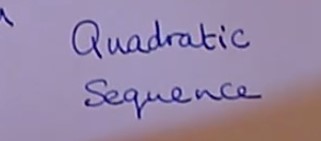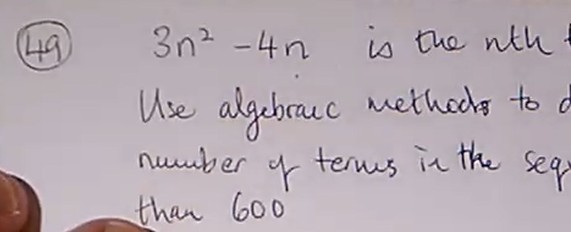Sequences from patterns

Look at the patterns and use them to find later terms in the sequence.

Sequences are sets of numbers that have an underlying rule that allows you to predict the next term. The rule is called the nth term or the closed form of the sequence. At GCSE, you study arithmetic, geometric, quadratic and Fibonacci sequences.
Arithmetic sequences are sequences that involve the addition or subtraction of the same amount with each new term. 1, 2, 3, 4, 5, 6,... is an arithmetic sequence. All the times tables are arithmetic sequences. Numbers that go up or down by the same amount, but start at a number not involved in the times table are arithmetic sequences (such as 7, 9, 11, 13,...). Sequences that go up or down by the same fraction or mixed number each time are also arithmetic sequences. Arithmetic sequences are also known as linear sequences. All other sequences (apart from the arithmetic ones) are known as non-linear sequences.
Geometric sequences are non-linear sequences. These sequences are formed by multiplying or dividing by the same number each time. 1, 3, 9, 27, 81, 243, ... is a geometric sequence where the next term is three times the size of the the last term. 2 to the power of 0, 2 to the power of 1, 2 to the power of 2, 2 to the power of 3 etc is a geometric sequence as the previous term is being multiplied by 2 each time. A half, a quarter, an eighth, a sixteenth is a geometric sequence as the previous term is being multiplied by a half each time.
Quadratic Sequences can be more difficult to spot than geometric or arithmetic sequences. They are non-linear sequences based on quadratic equations of the type ax^2 + bx + c. To find the value of a, you need to find the difference between successive terms and then find the difference between them. This gives you the value of 2a, so you need to halve this value to get a. This should leave you with an arithmetic sequence with which, the value of b and c will become easy to find.
Fibonacci sequences are non-linear sequences. You find the next term by adding the two previous terms together. So the classic Fibonacci sequence begins 1, 1, 2, 3, 5, 8, 13, 21, 34, 55,... It turns out that this sequence is really useful when studying nature and Fibonacci sequences can be found in all kinds of places throughout the natural world. Mathematicians since Leonardo Fibonacci of Pisa have developed other sequences using the same idea but using multiples of the previous two terms to find the next.

Find the nth term in a sequence and use this to find the 1005th term or higher.

Video on finding the nth term in a sequence. Find the 823rd term in the sequence. Find if 7000 is a term in the sequence.

Spreadsheet on missing numbers, inverse operations and geometric sequences.

Finding the nth term of a sequence and then using that to find the 100th, 200th terms etc.

Useful spreadsheet to make up quadratic sequences with which to test the students.

This is to help students to understand the work connected to Sequences Practice Pages. The practice pages can be found here.

This video runs through what the closed form means for values of n between certain bounds.

These sheets look at comparing a sequence to a graph, arithmetic sequences, geometric sequences (including the common difference), quadratic sequences, Fibonacci sequences, polygonal sequences.

This work looks at completing a sequence by filling in the missing terms; finding the nth term or closed form of the sequence; calculating the 800th term, for example; determining whether a number is a member of the sequence or not. Help is given in the video that you can find here.

Investigate one of four kinds of sequence to see what you can find out. This is the sort of thing people ought to be doing in maths more often.

Find the next term or two in each of these problems. Help with this work can be found here.

Find the next term or two in each of these problems. Find the nth term. What is the 500th term. Is 84927 a member of this sequence? These are the type of questions with which you will be faced here. Help exists though. Search here to find it.

This video runs through how to determine the closed form or nth term for a quadratic sequence.

A video on Count of Terms in a Quadratic Sequence below a Number